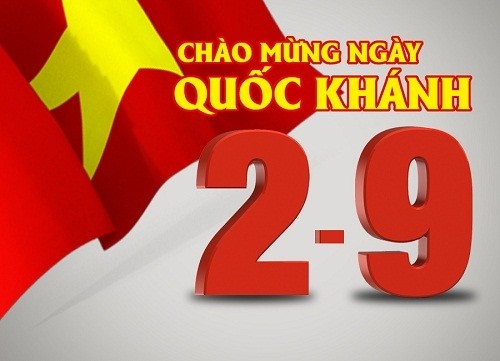 Vietnam National Day - September 2, 1945 - September 2, 2021 (photo: baochinhphu.vn) Vietnam National Day - September 2, 1945 - September 2, 2021 (photo: baochinhphu.vn) |
A: From England, Gerry Neumann said: “On the occasion of Vietnam’s National Day, I would like to send my best wishes to the staff of VOV, and also congratulations for the anniversary of VOV on September 7th. I hope the broadcasts will be heard around the world for many years to come, because you bring us a valuable source of information, not only about Vietnam – its people and culture – but also on other countries in the region. Best wishes, to all of you – please stay safe during this time of the pandemic.”
B: Lu Cheng Da of Zhejiang, China emailed us to say that he has listened to VOV since 2007 when he was in Guangxi. Due to close geographical location, he often listens to VOV’s shortwave programs to learn more about Vietnam’s society. He likes Colorful Vietnam-Vietnam’s 54 ethnic groups, Culture, and Discovery Vietnam, and stories about tourism.
A: On Vietnam’s 76th National Day and VOV’s 76th founding anniversary, Lu wishes that VOV will attract more listeners in mainland China as well as in Hong Kong, Macau, Taiwan, Singapore, Malaysia, and other countries and territories.
B: Gao Zhe, a listener in Sanxi, China told us that when he was a high school student in 2003, he tuned through shortwave frequencies and came across a Mandarin voice. He realized it was a VOV program.
A: Through VOV’s programs, Gao learned that VOV broadcast President Ho Chi Minh reading the Declaration of Independence to the world in 1945. On Vietnam’s 76th National Day and VOV’s 76th founding anniversary, Gao congratulates the friendly relationship between the two countries and VOV’s development.
B: Thank you all, listeners, for your beautiful wishes for Vietnam and VOV. This year, due to the COVID-19 pandemic, many cities and provinces in Vietnam are social distancing to prevent the spread of the coronavirus. We won’t have massive celebrations like in previous years. All resources have been reserved for medical services and social welfare to help people affected by the pandemic.
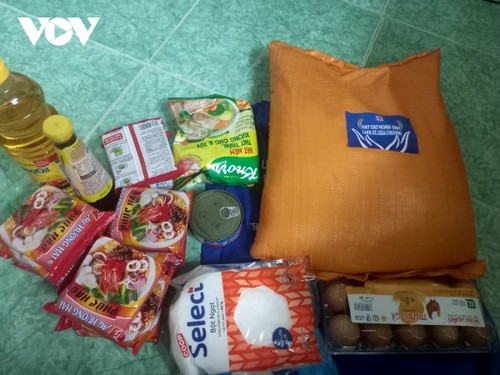 A welfare bag includes essential necessities such as rice, vegetables, sugar, soy sauce, seasoning powder, eggs, and more. (photo: VOV) A welfare bag includes essential necessities such as rice, vegetables, sugar, soy sauce, seasoning powder, eggs, and more. (photo: VOV) |
A: AdiHidayat, a listener of Jakarta, Indonesia, asks about “welfare bags” for people in HCMC.
B: More than 1 million people in HCMC have registered for a “welfare bag” through an online registration form of the Ministry of Information and Communications. Beneficiaries of the policy include employees who are laid off from work without pay, those who lost their jobs but are not eligible for unemployment insurance; freelance workers who lost their jobs, and household businesses that had to stop operating; and traders at local markets.
B: The welfare bag is part of an aid package for COVID-19 affected people in HCM City. Each bag, which is worth about 13USD, includes essential necessities such as rice, vegetables, sugar, soy sauce, seasoning powder, eggs, and more.
A: To receive the bag, HCM City residents register directly with the local government, or an online form. They access a link on the website of Ho Chi Minh City Media Center, fill in personal information, choose a welfare package in cash or kind, mark the right subject, press the "Send" button, and wait for the delivery of the “welfare bag”
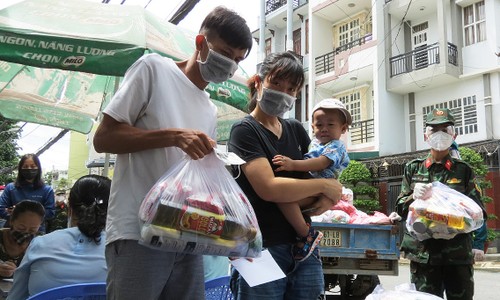 People affected by the COVID-19 pandemic receive welware bags during social distancing period. (photo: vnexpress) People affected by the COVID-19 pandemic receive welware bags during social distancing period. (photo: vnexpress) |
B: Sakae Onozawa of Japan introduced himself as a 59-year-old computer systems engineer. His hobbies are shortwave broadcasting and computational graphic creating. Sakae said he loves both traditional Vietnamese music and pop music and that VOV5’s showplays wonderful Vietnamese music. He is very interested in folk instruments from countries so listening to stories on Vietnamese folk instruments is a great pleasure for him.
A: Vietnam is home to 54 ethnic groups living in close harmony with nature. They have created different musical instruments using materials available around them, such as bamboo, rattan, leaves, rocks, and water. Music is an important aspect of their lives, for entertainment and worship purposes.
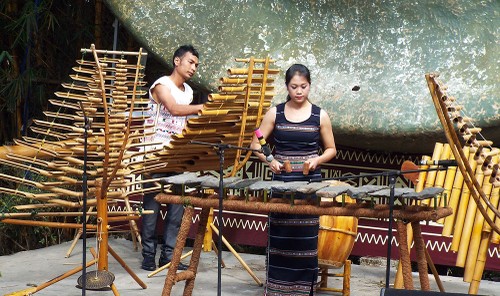 A orchestra of the T'rung and Dan Da (stone slabs) A orchestra of the T'rung and Dan Da (stone slabs) |
B: The T’rung is an iconic instrument of Vietnamese folk music, a medium of expression of joy and celebration. It is named after the ‘t’rung’ sound created when the bamboo pipes are struck.
A: It’s interesting to know that its name is the sound it produces. A simple T’rung xylophone has 5 to 7 bamboo hollows while a complex instrument has up to 48 pipes and intricate sound. The short pipes produce high-notes as compared to the longer ones. When struck in a particular order, melodious notes are created.
A: T’rung is one of the popular musical instruments closely associated with the spiritual life of the Bahnar, Sedan, Giarai, Ede and other ethnic minority groups in the Central Highlands of Vietnam.
B: Another integral instrument of Vietnamese musical symphonies and orchestras is the Dan Bau, literally translated as gourd-shaped lute. A unique feature of Dan Bau is that it has only one string, that’s why it’s also called “monochord”. Yet it can create music on the pentatonic scale. The earnestly melodies from Dan Bauinstantly stir deep emotions.
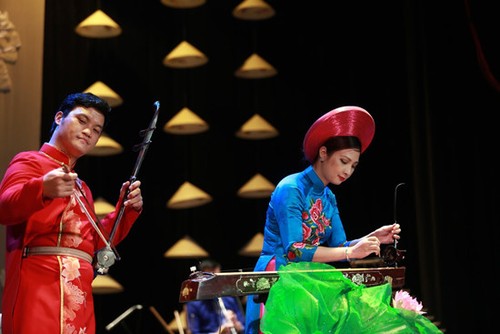 A woman plays the Dan Bau. A woman plays the Dan Bau. |
A: The body of Dan Bau is made of wood, often bamboo and reed. The strings which were originally made from silk-threads have now been replaced with iron string. This has led to considerable amplification of the sound and durability of the instrument.
B: The Dan Da, Vietnam’s authentic lithophone, is probably Vietnam’s most ancient musical instrument. Archaeologists have discovered ancient Dan Da dating back around 3,000 years.
A: The temporary Dan Da still looks rather primitive because it doesn’t use neatly arranged tiles and cut stones. Rather, it is a simple arrangement of stone slabs of different shapes and sizes. The stones are minimally processed and this retains their genuine rugged characteristics.
B: A set of 11 stone slabs with high resonance are arranged in a straight line, and the player strikes the stones with a pair of hammers to create sounds. The sound is very echoing and pacifying.
A: The Sao Truc or bamboo flute represents the zeal of Vietnamese countryside. These days the pleasant music from the flute is played alongside other traditional instruments in musical bands and in Vietnamese musical symphonies and orchestras. The flute is also played by solo artists.
B: The instrument is made of bamboo pipe. Originally, the flute was made with 6 finger-holes. The 10 finger-hole flute we see today was made popular by modern musicians in the 1970s.
A: We’ve talked about some of the most popular Vietnamese musical instruments. Please visit our website for more about our popular and very rare musical instruments.
B: Thank you all for tuning in to VOV’s English broadcast and leaving your comments on our Facebook fanpage. We always welcome your feedback at: English Service, VOVWorld, the Voice of Vietnam, 45 Ba Trieustreet, Hanoi, Vietnam. Or you can email us at: englishsection@vov.vn. We have more fantastic stories and videos on our website at vovworld.vn. Thank you all. Stay safe and healthy. Goodbye.